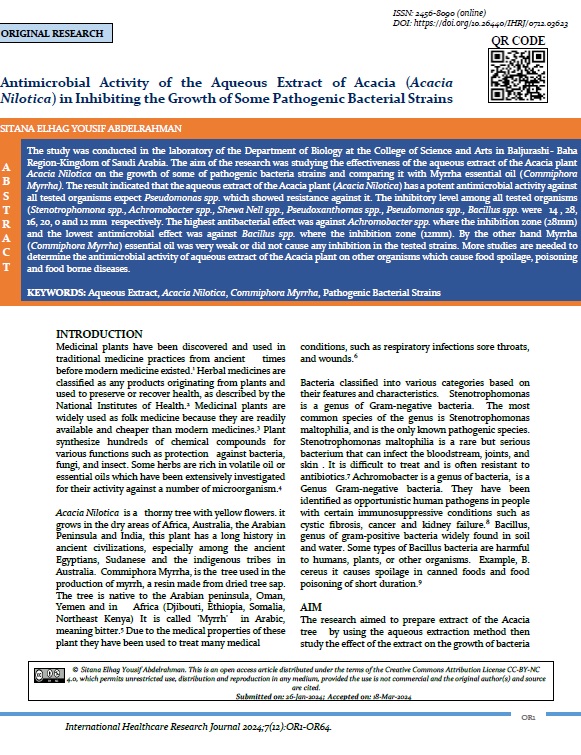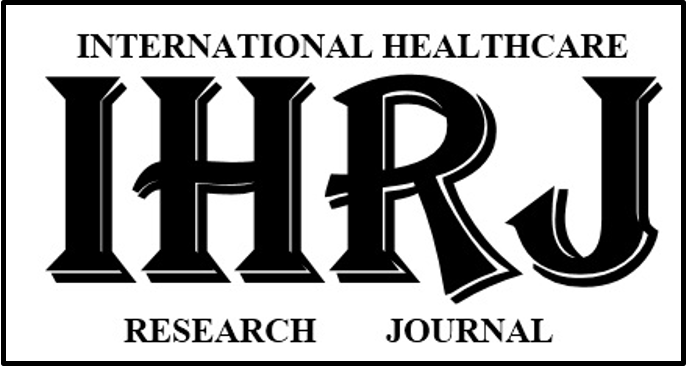Antimicrobial activity of the aqueous extract of Acacia (Acacia nilotica) in inhibiting the growth of some pathogenic bacterial strains
Abstract
The study was conducted in the laboratory of the Department of Biology at the College of Science and Arts in Baljurashi- Baha Region-Kingdom of Saudi Arabia. The aim of the research was studying the effectiveness of the aqueous extract of the Acacia plant Acacia Nilotica on the growth of some of pathogenic bacteria strains and comparing it with Myrrha essential oil (Commiphora Myrrha). The result indicated that the aqueous extract of the Acacia plant (Acacia Nilotica) has a potent antimicrobial activity against all tested organisms expect Pseudomonas spp. which showed resistance against it. The inhibitory level among all tested organisms (Stenotrophomona spp., Achromobacter spp., Shewa Nell spp., Pseudoxanthomas spp., Pseudomonas spp., Bacillus spp. were 14 , 28, 16, 20, 0 and 12 mm respectively. The highest antibacterial effect was against Achromobacter spp. where the inhibition zone (28mm) and the lowest antimicrobial effect was against Bacillus spp. where the inhibition zone (12mm). By the other hand Myrrha (Commiphora Myrrha) essential oil was very weak or did not cause any inhibition in the tested strains. More studies are needed to determine the antimicrobial activity of aqueous extract of the Acacia plant on other organisms which cause food spoilage, poisoning and food borne diseases.
Downloads
References
Swerdlow JL, Johnson L. Nature’s Medicine: Plants that Heal. Washington, DC: National Geographic Society; 2000.
National Institutes of Health Office of Dietary Supplements. Botanical Dietary Supplements: Background Information
Ahn K. The worldwide trend of using botanical drugs and strategies for developing global drugs. BMB Reports 2017;50(3): 111–6. doi:10.5483/BMBRep.2017.50.3.221.
Kalemba D, Kunicka A. Antibacterial and antifungal properties of essentials oils. Curr Med Chem. 2003;10: 813-39.
Judith S. The Natural History of Medicinal Plants. Timber Press 2000.pp 16. ISBN 978-0-88192-483-1.
Hauben L, Vauterin L, Moore E, Hoste B, Swings J . Genomic diversity of the genus Stenotrophomonas". Int J Syst Bacteriol. 1999;49 (4): 1749–60. doi:10.1099/00207713-49-4-1749.
Smith-Hall C, Larsen HO, Pouliot M. People, plants and health: a conceptual framework for assessing changes in medicinal plant consumption. J Ethnobiol Ethnomed. 2012; 8: 43. doi:10.1186/1746-4269-8-43.
Colin SE, Ruxana TS. Achromobacter Respiratory Infections. Annals of the American Thoracic Society. 2015;12 (2):252–8. doi:10.1513/AnnalsATS.201406-288FR.
Schippmann U, Cunningham AB, Leaman DJ. (2002). Impact of Cultivation and Gathering of Medicinal Plants on Biodiversity: Global Trends and Issues (Case Study No. 7). In Biodiversity and the Ecosystem Approach in Agriculture, Forestry and Fisheries, Satellite Event Session on the Occasion of the 9th Regular Session of the Commission on “Genetic Resources for Food and Agriculture”, Rome, 12-13 October 2002. FAO Document Repository of United Nations.
Swanston-Flatt SK, Day C, Bailey CJ, Flatt PR. Traditional plant treatments for diabetes. Studies in normal and streptozotocin diabetic mice. Diabetologia. 1990 Aug;33(8):462-4. doi: 10.1007/BF00405106.
Kavanagh K. Analytical Microbiology. Volume II, First edition, January 1972, eBook ISBN:9781483270555
Madkour MH. Effect of some herbal extracts on food pathogens, food spoilage bacteria and Culex pipiens stages. King Abud Alaziz University Jur 2011:doc30354
Arun A, Kaur G, Sharma AK. Antimicrobial activity of Acacia Nilotica against Various Clinical Isolates. Elixir Appl Botany. 2016;97:42260-2.

Copyright (c) 2024 Sitana Elhag Yousif Abdelrahman

This work is licensed under a Creative Commons Attribution-NonCommercial 4.0 International License.


